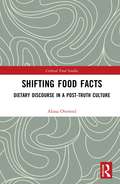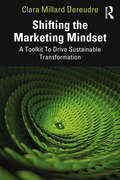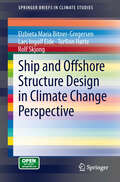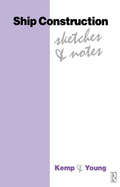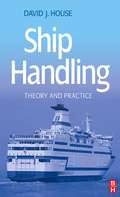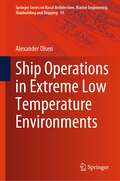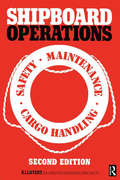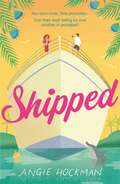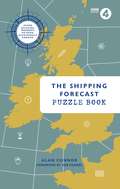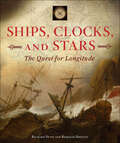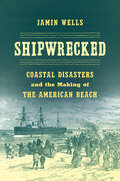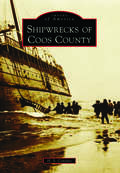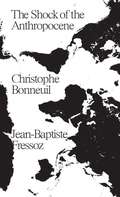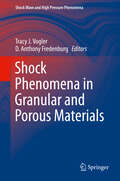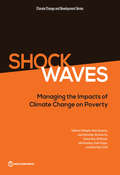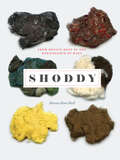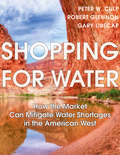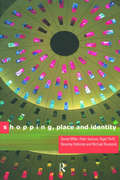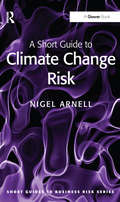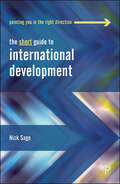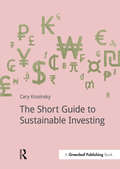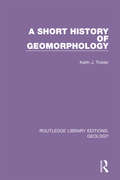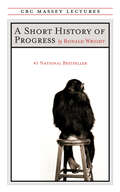- Table View
- List View
Shifting Food Facts: Dietary Discourse in a Post-Truth Culture (Critical Food Studies)
by Alissa OverendThis book offers a much-needed reframing of food discourse by presenting alternative ways of thinking about the changing politics of food, eating, and nutrition. It examines critical epistemological questions of how food knowledge comes to be shaped and why we see pendulum swings when it comes to the question of what to eat. As food facts peak and peril in the face of conflicting dietary advice and nutritional evidence, this book situates shifting food truths through a critical analysis of how healthy eating is framed and contested, particularly amid fluctuating truth claims of a “post-truth” culture. It explores what a post-truth epistemological framework can offer critical food and health studies, considers the type of questions this may enable, and looks at what can be gained by relinquishing rigid empirical pursuits of singular dietary truths. In focusing too intently on the separation between food fact and food fiction, the book argues that politically dangerous and epistemically narrow ideas of one way to eat “healthy” or “right” are perpetuated. Drawing on a range of archival materials related to food and health and interviews with registered dietitians, this book offers various examples of shifting food truths, from macro-historical genealogies to contemporary case studies of dairy, wheat, and meat. Providing a rich and innovative analysis, this book offers news ways to think about, and act upon, our increasingly complex food landscapes. It does so by loosening our empirical Western reliance on singular food facts in favour of an articulation of contextual food truths that situate the problems of health as problems of living, not as individualistic problems of eating. It will be of interest to students, scholars, and practitioners working in food studies, food politics, sociology, environmental geography, health, nutrition, and cultural studies.
Shifting the Marketing Mindset: A Toolkit To Drive Sustainable Transformation
by Clara Millard DereudreA clarion call for marketing to return to its roots and integrate sustainability principles, this book illustrates how the marketing function can drive organizations, delighting customers and impacting positively on society and the environment.Accused of manipulation and more, marketing is one of the most misused functions and misunderstood professions. The rise of “green marketing” could have been an opportunity for the profession to exhibit its potential to transform business—but instead, there has been a turn to greenwashing, with false claims of environmental friendliness. Now, businesses must evolve, rebalancing social and environmental priorities with economic ones, and it is time for a new era: Positive Impact Marketing. Drawing on almost 30 years of experience in global marketing, management, and strategy with private, public, and nonprofit organizations, this book introduces a framework organized around four key principles, Connect 4 Impact, and shows how these principles must govern marketing to achieve the desired net positive impact. It explains why and how marketing is key to establish sustainability at the core of business models and provides marketers with a toolkit and strategies for collaborating with other business leaders in the organization to guide rapid and effective transformations.This book will be a transformative resource for leaders and managers looking to truly incorporate sustainability into their business models, marketing professionals at all levels, and MBA/BBA students with an interest in sustainable business.
Ship and Offshore Structure Design in Climate Change Perspective (SpringerBriefs in Climate Studies)
by Torfinn Hørte Lars Ingolf Eide Tor Svensen Elzbieta Maria Bitner-Gregersen Rolf SkjongThis book summarizes results of longstanding research and scientific contributions from many projects and relevant working groups. It collects and evaluates wind and wave climate projections under changing climate having design needs and marine safety in focus. Potential impact of projected climate change in met-ocean conditions on ships and offshore structures is discussed and illustrated by an example of the expected wave climate change on tanker design. The monograph is intended for students, researchers and industry based engineers who want a summary of the many studies that have been carried out on climate change effects on wind and waves and their importance for design and operations of ship and offshore structures. The reader needs only a moderate knowledge of marine wind and wave climate to follow the text.
Ship Construction Sketches and Notes
by John F Kemp Peter YoungThis classic book in the Kemp and Young series has been fully revised and updated by David J Eyres, author of the well-known Butterworth-Heinemann title "Ship Construction," and will prove indispensable to the student reader. The contents cover, in numerous fully illustrated items, shipyard practices, principles of construction methods, the design and construction of the various component parts of the ship, and the overall arrangement of different types of merchant and passenger vessels.
Ship Handling
by David HouseSuitable as a training manual and a day-to-day reference, Shiphandling is the comprehensive and up to date guide to the theory and practice of ship handling procedures. Its covers the requirements of all STCW-level marine qualifications, provides expert guidance on all the hardware that marine professionals will make use of in the control and operation of their vessel and offers a broad focus on many shiphandling scenarios.
Ship Operations in Extreme Low Temperature Environments (Springer Series on Naval Architecture, Marine Engineering, Shipbuilding and Shipping #19)
by Alexander OlsenThis book recognizes the fact that the vessels' intended operational profile may vary as some vessels are intended to operate with the assistance of an ice breaker and others are intended to operate independently. The guidance provided in this book is proposed to apply to all vessels that are designed, equipped and intended to operate in low-temperature environments. Special attention is given to those vessels operating for extended periods in the Arctic regions, as this presents specific and unique challenges for vessels and crew members. The application of the guidance in this book is optional. When a vessel is designed, equipped, built and surveyed in accordance with the relevant class rules, and when found satisfactory during class notation survey, a classification notation may be granted which demonstrates the vessel's compliance with the appropriate class requirements for vessels operating in low-temperature environments. Those vessels that are designed to meet the requirements of an ice class are typically required to meet specific class rules around “strengthening for navigation in ice” or other equivalent and recognized ice class rules. Accordingly, this book also provides guidance related to the requirements which address the duration of emergency electrical power. This extended emergency power duration is expressed in hours and may be appended to the base optional class notations. To provide as much context as possible, this book refers to the most relevant international regulations and standards that are considered to be applicable. It is recommended that readers of this book refer to the most recent text of those regulations and standards when seeking to apply the guidance set out herein, as it is the intent of the book to remain consistent with the pertinent international regulations and standards developed by the global maritime industry.
Shipboard Operations
by H I LaveryThis book covers the knowledge of shipboard operations required by candidates for professional qualification as Chief Officer and Master Mariner. It deals with the basic routines and procedures, and the many regulations governing their use, for the safe and efficient operation of merchant ships. The book is also designated a fundamental text for the Maritime Transport paper of the Chartered Institute of Transport's membership examinations. The second edition takes into account recent developments in technology and regulation, and in particular covers major international legislation on Safety of Life at Sea and on Maritime Pollution as well as recent UK regulations on occupational health and safety and on operation of ro-ro ferries.
Shipped: If you're looking for a witty, escapist, enemies-to-lovers rom-com, filled with 'sun, sea and sexual tension', this is the book for you!
by Angie HockmanPerfect for fans of Christina Lauren and Sally Thorne, escape with Shipped - the whipsmart and escapist romantic comedy that celebrates the power of second chances and the magic of new beginnings.'An extraordinary debut. Witty, romantic, and completely addictive' Lauren Layne, New York Times bestselling author of Passion on Park Avenue'Shipped is a sweet, sunny getaway of a novel with an ambitious heroine I liked right away and a hero who's *chef's kiss* a supportive dreamboat (pun intended). A vicarious enemies-to-lovers trip to the Galapagos was exactly what I needed right about now. I stan an environmentally aware romance' Sarah Hogle, author of You Deserve Each Other'Shipped is exactly what we all need right now: a rollicking rom-com with a conscience. Through lush description and sparkling prose, Angie Hockman takes us on an exhilarating journey to the Galapagos Islands and straight into the hearts of her characters. I relished every swoony second I spent reading this story, and I can't wait to see what Angie comes up with next!' Kristin Rockaway, author of She's Faking It'Witty, charming as hell, and layered with real passion for ecotourism, Shipped is a sparkling debut. The perfect slice of vacation in book form' Rosie Danan, author of The RoommateTwo arch-rivals. One promotion. Can they resist falling for one another in paradise?Marketing manager Henley Evans barely has time for herself, let alone family, friends, or dating. But when she's shortlisted for her dream promotion, the sacrifices finally seem worth it. If only Graeme Crawford-Collins, the remote social media manager/bane of her existence, wasn't also up for the position. Although they've never met in person, their epic email battles are the stuff of office legend. The task: draft a proposal on how to boost bookings in the Galápagos. The catch? They have to go on a company cruise...together. But when they meet on the ship, Henley is shocked to discover that the real Graeme is nothing like she imagined - and the line between loathing and liking is thinner than a postcard. With her career dreams in sight and a growing attraction to the competition, Henley begins questioning her life choices. Because what's the point of working all the time if you never actually live?'Enchanting, hilarious and a perfectly delightful escape! I loved every second of this enemies-to-lovers romance' Nina Bocci, USA Today bestselling author of On the Corner of Love and Hate'Flirty and fun, with a starring couple you'll fall in love with, Shipped is an eco-conscious rom-com with great characters, lots of laughs, and a stunning location...I'm sold!' Sarah Morgenthaler, author of The Tourist Attraction'Angie Hockman sparkles in this unputdownable enemies-to-lovers romance!' Miranda Liasson, author of Then There was You 'Shipped is the hilarious rom-com we all need right now' Kerry Winfrey, author of Waiting for Tom Hanks'Shipped is the most wonderful escape! In this sweet, enemies to lovers rom-com, Angie Hockman seriously delivers. I can't wait to see what she brings us next!' Alexa Martin, author of Intercepted
The Shipping Forecast Puzzle Book
by Alan ConnorAttention all Shipping Forecast fans. Set sail on a voyage unlike any other...Each day, millions tune in to hear the Shipping Forecast's unique cadence and poetry, words thatturn our island landscape into something strangeand magical. It's almost like a puzzle to be solved...The Shipping Forecast Puzzle Book tests your general knowledge and lateral thinking through a series of fiendish puzzles, in which all the answers can be found on a map as place names on the coasts or in the seas. For example:· An eagle's under this· What a Komodo Dragon really is· Near where someone was horribly cruel to 343 felinesAnd because your voyages trace the shapes of letters of the alphabet, that's just the beginning...With a foreword by Zeb Soanes, the voice of the Shipping Forecast, and fully illustrated with specially commissioned maps, The Shipping Forecast Puzzle Book will help make you a Master of the quizzing world.
Ships, Clocks, and Stars: The Quest for Longitude
by Richard Dunn Rebekah HiggittA tale of eighteenth-century invention and competition, commerce and conflict, this is a lively, illustrated, and accurate chronicle of the search to solve “the longitude problem,” the question of how to determine a ship’s position at sea—and one that changed the history of mankind.Ships, Clocks, and Stars brings into focus one of our greatest scientific stories: the search to accurately measure a ship’s position at sea. The incredible, illustrated volume reveals why longitude mattered to seafaring nations, illuminates the various solutions that were proposed and tested, and explores the invention that revolutionized human history and the man behind it, John Harrison. Here, too, are the voyages of Captain Cook that put these revolutionary navigational methods to the test.Filled with astronomers, inventors, politicians, seamen, and satirists, Ships, Clocks, and Stars explores the scientific, political, and commercial battles of the age, as well as the sailors, ships, and voyages that made it legend—from Matthew Flinders and George Vancouver to the voyages of the Bounty and the Beagle.Featuring more than 150 photographs specially commissioned from Britain’s National Maritime Museum, this evocative, detailed, and thoroughly fascinating history brings this age of exploration and enlightenment vividly to life.
Shipwrecked: Coastal Disasters and the Making of the American Beach
by Jamin WellsReframing the American story from the vantage point of the nation's watery edges, Jamin Wells shows that disasters have not only bedeviled the American beach--they created it. Though the American beach is now one of the most commercialized, contested, and engineered places on the planet, few people visited it or called it home at the beginning of the nineteenth century. By the twentieth century, the American beach had become the summer encampment of presidents, a common destination for millions of citizens, and the site of rapidly growing beachfront communities. Shipwrecked tells the story of this epic transformation, arguing that coastal shipwrecks themselves changed how Americans viewed, used, and inhabited the shoreline.Drawing on a broad range of archival material--including logbooks, court cases, personal papers, government records, and cultural ephemera--Wells examines how shipwrecks laid the groundwork for the beach tourism industry that would transform the American beach from coastal frontier to oceanfront playspace, spur substantial state and private investment alongshore, reshape popular ideas about the coast, and turn the beach into a touchstone of the American experience.
Shipwrecks of Coos County (Images of America)
by H. S. ContinoEuropean settlement of Coos County began with a shipwreck. The Captain Lincoln wrecked on the north spit of the Coos Bay in January 1852. The crewmen built a temporary camp out of the ship's sails and named it "Camp Cast-Away." This was the first white settlement in the area. The men eventually traveled overland to Port Orford, where they told other settlers about the Coos Bay and its many natural resources. By December 1853, Coos County was established by the territorial legislature, and several towns were founded; the history of the area had been completely altered by a single shipwreck.
Shipwrecks of Curry County (Images of America)
by H. S. ContinoHistorically, mariners considered the Oregon coast one of the most dangerous in the world. In 1852, explorers discovered gold in the rivers and along the beaches in Curry County, which is located in the southwestern corner of the state. Subsequent settlement concentrated on the coast. With few roads, water transportation was crucial for early settlers. The area contained many potential dangers to ships, including unpredictable weather, frequent fog, and submerged rocks and reefs. There have been many shipwrecks in the area like that of the tanker Larry Doheny, which was torpedoed by a Japanese submarine during World War II. Curry County is home to Cape Blanco, the second most westerly point in the continental United States, and Port Orford, the only open-water port on the Oregon coast (and one of only six “dolly” ports in the world). Modern technology and port improvements have reduced the number of shipwrecks, but accidents still occur.
The Shock of the Anthropocene: The Earth, History and Us
by Christophe Bonneuil Jean-Baptiste Fressoz David FernbachDissecting the new theoretical buzzword of the "Anthropocene" The Earth has entered a new epoch: the Anthropocene. What we are facing is not only an environmental crisis, but a geological revolution of human origin. In two centuries, our planet has tipped into a state unknown for millions of years. How did we get to this point? Refuting the convenient view of a "human species" that upset the Earth system, unaware of what it was doing, this book proposes the first critical history of the Anthropocene, shaking up many accepted ideas: about our supposedly recent "environmental awareness," about previous challenges to industrialism, about the manufacture of ignorance and consumerism, about so-called energy transitions, as well as about the role of the military in environmental destruction. In a dialogue between science and history, The Shock of the Anthropocene dissects a new theoretical buzzword and explores paths for living and acting politically in this rapidly developing geological epoch.
Shock Phenomena in Granular and Porous Materials (Shock Wave and High Pressure Phenomena)
by Tracy J. Vogler D. Anthony FredenburgGranular forms of common materials such as metals and ceramics, sands and soils, porous energetic materials (explosives, reactive mixtures), and foams exhibit interesting behaviors due to their heterogeneity and critical length scale, typically commensurate with the grain or pore size. Under extreme conditions of impact, granular and porous materials display highly localized phenomena such as fracture, inelastic deformation, and the closure of voids, which in turn strongly influence the bulk response. Due to the complex nature of these interactions and the short time scales involved, computational methods have proven to be powerful tools to investigate these phenomena. Thus, the coupled use of experiment, theory, and simulation is critical to advancing our understanding of shock processes in initially porous and granular materials. This is a comprehensive volume on granular and porous materials for researchers working in the area of shock and impact physics. The book is divided into three sections, where the first presents the fundamentals of shock physics as it pertains to the equation of state, compaction, and strength properties of porous materials. Building on these fundamentals, the next section examines several applications where dynamic processes involving initially porous materials are prevalent, focusing on the areas of penetration, planetary impact, and reactive munitions. The final section provides a look at emerging areas in the field, where the expansion of experimental and computational capabilities are opening the door for new opportunities in the areas of advanced light sources, molecular dynamics modeling, and additively manufactured porous structures. By intermixing experiment, theory, and simulation throughout, this book serves as an excellent, up-to-date desk reference for those in the field of shock compression science of porous and granular materials.
Shock Waves
by Stephane Hallegatte Adrien Vogt-Schilb Laura Bonzanigo Julie Rozenberg Mook Bangalore Tamaro Kane Ulf Narloch Fay David TreguerEnding poverty and stabilizing climate change will be two unprecedented global achievements and two major steps toward sustainable development. But the two objectives cannot be considered in isolation: they need to be jointly tackled through an integrated strategy. This report brings together those two objectives and explores how they can more easily be achieved if considered together. It examines the potential impact of climate change and climate policies on poverty reduction. It also provides guidance on how to create a "win-win ? situation so that climate change policies contribute to poverty reduction and poverty-reduction policies contribute to climate change mitigation and resilience building. The key finding of the report is that climate change represents a significant obstacle to the sustained eradication of poverty, but future impacts on poverty are determined by policy choices: rapid, inclusive, and climate-informed development can prevent most short-term impacts whereas immediate pro-poor, emissions-reduction policies can drastically limit long-term ones.
Shoddy: From Devil’s Dust to the Renaissance of Rags (science.culture)
by Hanna Rose ShellThe history of modern-day old clothes recycling begins with a thing called shoddy. Starting in the early 1800s, shoddy was the name given to a new material made from reclaimed wool, and to one of the earliest forms of industrial recycling. Old rags and leftover fabric clippings were ground to bits by a machine known as “the devil” and then re-used. Usually undisclosed, shoddy–also known as reworked wool–became suit jackets, army blankets, mattress stuffing, and much more. Shoddy is the afterlife of rags. And Shoddy, the book, reveals hidden worlds of textile intrigue. In Shoddy: From Devil’s Dust to the Renaissance of Rags, Hanna Rose Shell takes readers on a journey to discover shoddy, from Haiti to the “shoddy towns” of West Yorkshire in England, to the United States, back in time to the British cholera epidemics and the American Civil War, and into agricultural fields, textile labs, and rag-shredding factories. Shell’s narrative is both literary and historical, drawing on an extraordinary range of sources, from court cases to military uniforms, mattress labels to medical textbooks, political cartoons to high art. Shoddy moves between genres, bringing richly drawn characters and unexpected objects to life. Along the way, shoddy becomes equally an evocative object and a portal into another world. Almost since the time it first appeared, shoddy was both ubiquitous and controversial. In part because it was often so hard to detect, it was inherently suspicious. Public health experts worried about sanitation and disease—how could old clothes be disinfected? As well, the idea of wearing someone else’s old clothes so close to your own skin was discomforting in and of itself. Could you sleep peacefully knowing that your mattress was very likely to be stuffed with dead soldiers’ overcoats? The use of the term “virgin” wool, the idea of virginity in relation to clothes, in fact emerged as an effort by the wool industry to counter shoddy’s appeal: to make shoddy seem shoddy. Over time, shoddy would capture a host of personal, ethical, commercial, and societal failings. And yet, there was always, within shoddy, the alluring concept of regeneration, of what we today think of as conscious clothing, eco-fashion, sustainable textiles. Shell exposes an interwoven tale of industrial espionage, political infighting, scientific inquiry, ethnic prejudices, and war profiteering. Discarded clothes may make many journeys over the course of several lifetimes. Not only in your garments, but under your rug, in your mattress pads, piano blankets, in the peculiar confetti-like stuffing in your mailing envelopes, even in the insulation in your walls. Though it began with wool, over the past century the shredding “devil” has turned to synthetics from nylon stockings to Kevlar. Shoddy is likely connected to something you are wearing right now. After reading, you will never use the word shoddy or think about your clothes, the environment, sustainability, or the intermingled world around you the same way again.
Shopping for Water
by Peter Culp Robert Glennon Gary LibecapThe American West has a long tradition of conflict over water. But after fifteen years of drought across the region, it is no longer simply conflict: it is crisis. In the face of unprecedented declines in reservoir storage and groundwater reserves throughout the West, Shopping for Water focuses on a set of policies that could contribute to a lasting solution: using market forces to facilitate the movemof water resources and to mitigate the risk of water shortages. Shopping for Water begins by reviewing key dimensions of this problem: the challenges of population and economic growth, the environmental stresses from overuse of common water resources, the risk of increasing water-supply volatility, and the historical disjunction that has developed between and among rural and urban water users regarding the amount we consume and the price we pay for water. The authors then turn to five proposals to encourage the broader establishmand use of market institutions to encourage reallocation of water resources and to provide new tools for risk mitigation. Each of the five proposals offers a means of building resilience into our water managemsystems.
Shopping, Place and Identity
by Daniel Miller Peter Jackson Michael RowlandsFirst published in 1998. Routledge is an imprint of Taylor & Francis, an informa company.
A Short Guide to Climate Change Risk (Short Guides to Business Risk)
by Nigel ArnellClimate change poses a risk to business operations and to markets, and a poor business response to this risk can lead to reputational damage, or worse. At the same time, climate change can bring opportunities for some businesses. In this addition to Gower’s series of Short Guides to Business Risk, Professor Arnell, one of the world’s leading experts in the field, reviews this critical area of risk posed to businesses and other organisations by climate change and considers how they can respond to this threat. A Short Guide to Climate Change Risk focuses on the impacts and consequences of climate change rather than on business use of energy or business and 'sustainability' issues. The author examines the advantages and disadvantages of different approaches to addressing these risks, with international case study examples. With chapters on the nature, science and politics of climate change, on the assessment and management of climate change risks, and recommendations for incorporating climate change risks into a Company Risk Management System, this concise guide serves the needs of business students and practitioners across a wide range of sectors, public and private.
The Short Guide to International Development (Short Guides)
by Nick SageInternational development is a vibrant, interdisciplinary area of the social sciences. This Short Guide offers a uniquely succinct and balanced account of this politically charged subject. It distils both the classic and newer debates together in a clear framework and illustrates them with contemporary examples. Designed to introduce a wide readership to international development, the book: • considers how far the field has been reconfigured over time and to what extent it is likely to change in the future; • reviews contemporary topics including tourism, migration and digital technologies; • includes distinctive international case studies and examples. By providing a succinct evaluation of competing approaches to, and perspectives on, the idea and practice of international development, this book offers students across the social sciences a distinct and invaluable introduction to the field.
The Short Guide to Sustainable Investing (Doshorts Ser.)
by Cary KrosinskyThe vast majority of invested assets do not consider environmental, social or governance (ESG) factors. Socially responsible investing (SRI) emerged to address these challenges, but it remains largely deployed in "negative strategies" such as sector screening, and continues to be a small investment niche, largely due to perceptions about potential underperformance.Sustainable investing is a new, more positive investment construct, described as "an investment discipline that explicitly considers future social and environmental trends in financial decision making, in order to provide the best risk-adjusted and opportunity-directed returns for investors. By anticipating these trends ahead of the market, sustainable investing seeks to identify 'predictable surprises' that can help maximize value over the long term."This concise guide by one of the sector's leading experts: Disentangles the terminology around SRI and describes a new, positive, opportunities-oriented paradigm for sustainable investing Showcases funds and strategies that are delivering outperformance within ecological limitsSets out the key megatrends and scenarios which investors need to consider, and Offers a practical guide to constructing a sustainable portfolio. This is absolutely essential reading for investors, fund managers and analysts who need to get up to speed on sustainable investing.
A Short History of Geomorphology (Routledge Library Editions: Geology #26)
by Keith J. TinklerThis book, first published in 1985, is a comprehensive guide to the main ideas in the history of geomorphology. It traces the development of thinking on landforms, with material ranging from the ancient world to the present day. The main areas covered are the Renaissance, the explosive growth of the Natural Sciences in the nineteenth century and the impact of the Second World War. The papers and theories of specialists like James Hutton, John Playfair and W.M. Davies are presented and discussed and the final chapters reflect on future change, based on the past and speculation on possible developments. Balance is maintained between the dual importance and dominance of English and North American contributions to the subject, and quite substantial research was undertaken to provide a more complete approach to some areas hitherto neglected.
A Short History of Progress: Fifteenth Anniversary Edition (The CBC Massey Lectures)
by Ronald WrightNow more relevant than ever, Ronald Wright’s #1 national bestseller, A Short History of Progress. The fifteenth anniversary edition includes a new introduction warning of the accelerating patterns of progress and disaster.Each time history repeats itself, so it’s said, the price goes up. The twentieth century was a time of runaway growth in human population, consumption, and technology, placing a colossal load on all natural systems, especially earth, air, and water — the very elements of life. The most urgent questions of the twenty-first century are: Where will this growth lead? Can it be consolidated or sustained? And what kind of world is our present bequeathing to our future?In his #1 national bestseller A Short History of Progress Ronald Wright argues that our modern predicament is as old as civilization, a 10,000-year experiment we have participated in but seldom controlled. Only by understanding the patterns of triumph and disaster that humanity has repeated around the world since the Stone Age can we recognize the experiment’s inherent dangers, and, with luck and wisdom, shape its outcome. In his new introduction to the fifteenth anniversary edition, Wright looks at the past fifteen years of human innovation — and asks whether we can still get the future right.
A Short Introduction to Climate Change
by Tony EggletonA Short Introduction to Climate Change provides a clear, balanced and well documented account of one of the most important issues of our time. It covers developments in climate science over the past 250 years and shows that recent climate change is more than the result of natural variability. It explains the difference between weather and climate by examining changes in temperature, rainfall, Arctic ice and ocean currents. It also considers the consequences of our use of fossil fuels and discusses some of the ways to reduce further global warming. Tony Eggleton avoids the use of scientific jargon to provide a reader-friendly explanation of the science of climate change. Concise but comprehensive, and richly illustrated with a wealth of full-colour figures and photographs, A Short Introduction to Climate Change is essential reading for anyone who has an interest in climate science and in the future of our planet.
